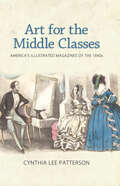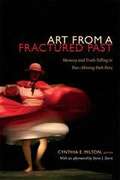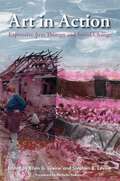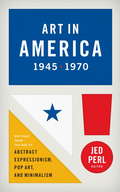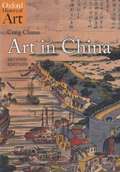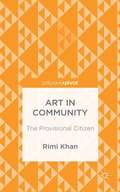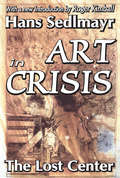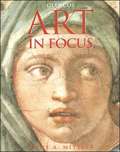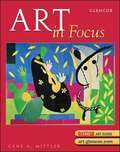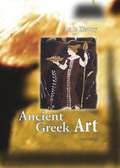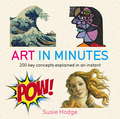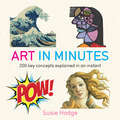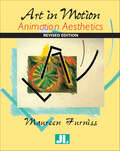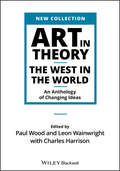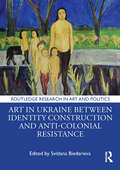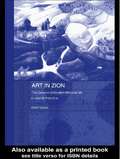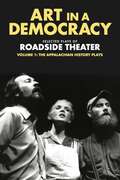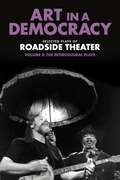- Table View
- List View
Art for the Middle Classes: America's Illustrated Magazines of the 1840s
by Cynthia Lee PattersonHow did the average American learn about art in the mid-nineteenth century? With public art museums still in their infancy, and few cities and towns large enough to support art galleries or print shops, Americans relied on mass-circulated illustrated magazines. One group of magazines in particular, known collectively as the Philadelphia pictorials, circulated fine art engravings of paintings, some produced exclusively for circulation in these monthlies, to an eager middle-class reading audience. These magazines achieved print circulations far exceeding those of other print media (such as illustrated gift books or catalogs from art-union membership organizations). Godey's, Graham's, Peterson's, Miss Leslie's, and Sartain's Union Magazine included two to three fine art engravings monthly, “tipped in” to the fronts of the magazines, and designed for pull-out and display. Featuring the work of a fledgling group of American artists who chose American rather than European themes for their paintings, these magazines were crucial to the distribution of American art beyond the purview of the East Coast elite to a widespread middle-class audience. Contributions to these magazines enabled many American artists and engravers to earn, for the first time in the young nation's history, a modest living through art. Author Cynthia Lee Patterson examines the economics of artistic production, innovative engraving techniques, regional imitators, the textual “illustrations” accompanying engravings, and the principal artists and engravers contributing to these magazines.
Art from Trash (Fountas & Pinnell Classroom, Guided Reading Grade 1)
by Danielle BerkowNIMAC-sourced textbook
Art from a Fractured Past: Memory and Truth Telling in Post–Shining Path Peru
by Cynthia E. MiltonPeru's Truth and Reconciliation Commission not only documented the political violence of the 1980s and 1990s but also gave Peruvians a unique opportunity to examine the causes and nature of that violence. In Art from a Fractured Past, scholars and artists expand on the commission's work, arguing for broadening the definition of the testimonial to include various forms of artistic production as documentary evidence. Their innovative focus on representation offers new and compelling perspectives on how Peruvians experienced those years and how they have attempted to come to terms with the memories and legacies of violence. Their findings about Peru offer insight into questions of art, memory, and truth that resonate throughout Latin America in the wake of "dirty wars" of the last half century. Exploring diverse works of art, including memorials, drawings, theater, film, songs, painted wooden retablos (three-dimensional boxes), and fiction, including an acclaimed graphic novel, the contributors show that art, not constrained by literal truth, can generate new opportunities for empathetic understanding and solidarity.Contributors. Ricardo Caro Cárdenas, Jesús Cossio, Ponciano del Pino, Cynthia M. Garza, Edilberto Jímenez Quispe, Cynthia E. Milton, Jonathan Ritter, Luis Rossell, Steve J. Stern, María Eugenia Ulfe, Víctor Vich, Alfredo Villar
Art in Action
by Stephen K. Levine Ellen G. LevineThe field of expressive arts is closely tied to the work of therapeutic change. As well as being beneficial for the individual or small group, expressive arts therapy has the potential for a much wider impact, to inspire social action and bring about social change. The book's contributors explore the transformative power of the arts therapies in areas stricken by conflict, political unrest, poverty or natural disaster and discuss how and why expressive arts works. They look at the ways it can be used to engage community consciousness and improve social conditions whilst taking into account the issues that arise within different contexts and populations. Leading expressive arts therapy practitioners give inspiring accounts of their work, from using poetry as a tool in trauma intervention with Iraqi survivors of war and torture, to setting up storytelling workshops to aid the integration of Ethiopian Jewish immigrants in Israel. Offering visionary perspectives on the role of the arts in inspiring change at the community or social level, this is essential reading for students and practitioners of creative and expressive arts therapies, as well as psychotherapists, counsellors, artists and others working to effect social change.
Art in America 1945-1970: Writings from the Age of Abstract Expressionism, Pop A
by Various Jed PerlExperience the creative explosion that transformed American art, in the words of the artists, writers, and critics who were there: In the quarter century after the end of World War II, a new generation of painters, sculptors, and photographers transformed the face of American art and shifted the center of the art world from Paris to New York. Signaled by the triumph of abstraction and the ascendancy of painters such as Pollock, Rothko, de Kooning, and Kline, this revolution generated an exuberant and contentious body of writing without parallel in our cultural history. In the words of editor Jed Perl, "there has never been a period when the visual arts have been written about with more mongrel energy--with more unexpected mixtures of reportage, rhapsody, analysis, advocacy, editorializing, and philosophy." Perl has gathered the best of this writing together for the first time, interwoven with fascinating headnotes that establish the historical background, the outsized personalities of the artists and critics, and the nature of the aesthetic battles that defined the era. Here are statements by the most significant artists, and major critical essays by Clement Greenberg, Susan Sontag, Hilton Kramer, and other influential figures. Here too is an electrifying array of responses by poets and novelists, reflecting the free interplay between different art forms: John Ashbery on Andy Warhol, James Agee on Helen Levitt, James Baldwin on Beauford Delaney, Truman Capote on Richard Avedon, Tennessee Williams on Hans Hofmann, Jack Kerouac on Robert Frank. The atmosphere of the time comes to vivid life in memoirs, diaries, and journalism by Peggy Guggenheim, Dwight Macdonald, Calvin Tomkins, and others. Lavishly illustrated with scores of black-and-white images and a 32-page color insert, this is a book that every art lover will treasure.
Art in China (2nd Edition)
by Craig ClunasChina boasts a history of art lasting over 5,000 years and embracing a huge diversity of forms - objects of jade, lacquer and porcelain, painted scrolls and fans, sculptures in stone, bronze and wood, and murals. But this rich tradition has not, until now been fully appreciated in the West where scholars have focused attention on the European high arts of painting and sculpture, downplaying arts more highly prized by the Chinese themselves, such as calligraphy. Art in China marks a breakthrough in the study of the subject. Drawing on recent innovative scholarship - and newly-accessible studies in China itself - Craig Clunas surveys the full spectrum of the visual arts in China. He ranges from the Neolithic period to the art scene of the early 21st century,examining Chinese art in a variety of contexts - as it has been designed for tombs, commissioned by rulers, displayed in temples, created by the men and women of the educated elite, and bought and sold in the marketplace. This updated edition contains expanded coverage of modern and contemporaryart, from the fall of the empire in 1911 to the growing international interest in the art of an increasingly confident and booming China.
Art in Community: The Provisional Citizen
by Rimi KhanThe arts are situated at the centre of policies and programs seeking to make communities more creative, cohesive or productive. This book highlights the governmental, aesthetic and economic contexts which shape art in community, offering a constructive account of the ties between government, culture and the citizen.
Art in Crisis: The Lost Center
by Hans SedlmayrThe history of art from the early nineteenth century on- ward is commonly viewed as a succession of conflicts between innovatory and established styles that culminated in the formalism and aesthetic autonomy of high modernism. In Art and Crisis, first published in 1948, Hans Sedlmayr argues that the aesthetic disjunctures of modern art signify more than matters of style and point to much deeper processes of cultural and religious disintegration. As Roger Kimball observes in his informative new introduction, Art in Crisis is as much an exercise in cultural or spiritual analysis as it is a work of art history. Sedlmayr's reads the art of the last two centuries as a fever chart of the modern age in its greatness and its decay. He discusses the advent of Romanticism with its freeing of the imagination as a conscious sundering of art from humanist and religious traditions with the aesthetic treated as a category independent of human need. Looking at the social purposes of architecture, Sedlmayr shows how the landscape garden, the architectural monument, and the industrial exhibition testified to a new relationship not only between man and his handiwork but also between man and the forces that transcend him. In these institutions man deifies his inventive powers with which he hopes to master and supersede nature. Likewise, the art museum denies transcendence through a cultural leveling in which Heracles and Christ become brothers as objects of aesthetic contemplation. At the center of Art in Crisis is the insight that, in art as in life, the pursuit of unqualified autonomy is in the end a prescription for disaster, aesthetic as well as existential. Sedlmayr writes as an Augustinian Catholic. For him, the underlying motive for the pursuit of autonomy is pride. The lost center of his subtitle is God. The dream of autonomy, Sedlmayr argues, is for finite, mortal creatures, a dangerous illusion. The book invites serious analysis from art cri
Art in Focus (4th Edition)
by Gene A. MittlerTHE MOST IMPRESSIVE AND ACCESSIBLE ART PROGRAM AVAILABLECompletely redesigned, Art in Focus is filled with colorful reproductions, photographs, graphics, and student artwork, all designed to challenge, surprise, and inspire your students to create and appreciate art. Your students expect something a little different from art class. The 2000 edition of Art In Focus offers the kind of inspiration and challenge your students expect. It is filled with more colorful reproductions, photos, and graphics than ever before. It uses both words and graphics to highlight relevant art topics. It integrates technology resources. It even features student artwork, so your students can see that talent can be celebrated and acknowledged at any age.
Art in Focus: Aesthetics, Criticism, History, Studio (5th edition)
by Gene A. MittlerArt in Focus - the premier high school art history text! An integrated, chronological approach to the study of art, Art in Focus demonstrates the interrelationships of aesthetics, art criticism, art history, and studio art.
Art in History: Ancient Greek Art
by Susie HodgeExamines the art of ancient Greece, including mosaics, pottery, sculpture, architecture, and paintings.
Art in Minutes
by Susie HodgeThe perfect compact reference guide for all would-be art buffs. Art historian Susie Hodge takes you on a whistle-stop international tour of all the major artistic cultures, movements, phases, developments, artists and themes, from Prehistoric art to Hyperrealism. Contents also include Greek classicism, Gothic art, the Renaissance, Baroque, Romanticism, Realism, Impressionism, Cubism, surrealism, Pop art and Minimalism.
Art in Minutes (IN MINUTES)
by Susie HodgeThe perfect compact reference guide for all would-be art buffs. Art historian Susie Hodge takes you on a whistle-stop international tour of all the major artistic cultures, movements, phases, developments, artists and themes, from Prehistoric art to Hyperrealism. Contents also include Greek classicism, Gothic art, the Renaissance, Baroque, Romanticism, Realism, Impressionism, Cubism, surrealism, Pop art and Minimalism.
Art in Minutes: 200 Key Concepts Explained In An Instant (In Minutes)
by Susie HodgeThis concise yet comprehensive guide to the history of art is the perfect handbook for all would-be art buffs. Art historian Susie Hodge takes you on a whistle-stop international tour of all the major philosophies, movements, phases, developments, artists, and themes, from prehistoric art to Hyperrealism. Other concepts covered include Greek classicism, Gothic art, the Renaissance, Baroque, Romanticism, Realism, Impressionism, Cubism, surrealism, Pop art, and Minimalism.
Art in Motion (Fountas & Pinnell Classroom, Guided Reading Grade 5)
by Kate DopirakA Drive to Create Many people think art is only paintings and sculptures. But what about a car? Can it be art too? Learn how some people transform plain old cars into moving works of art. NIMAC-sourced textbook
Art in Motion: Animation Aesthetics
by Maureen FurnissArt in Motion, Revised Edition is the first comprehensive examination of the aesthetics of animation in its many forms. It gives an overview of the relationship between animation studies and media studies, then focuses on specific aesthetic issues concerning flat and dimensional animation, full and limited animation, and new technologies. A series of studies on abstract animation, audiences, representation, and institutional regulators is also included.
Art in Nature (Fountas & Pinnell Classroom, Guided Reading Grade 1)
by Susan StubbsNIMAC-sourced textbook
Art in Public
by Lambert ZuidervaartThis book examines fundamental questions about funding for the arts: Why should governments provide funding for the arts? What do the arts contribute to daily life? Do artists and their publics have a social responsibility? Challenging questionable assumptions about the state, the arts, and a democratic society, Lambert Zuidervaart presents a vigorous case for government funding, based on crucial contributions the arts make to civil society. He argues that the arts contribute to democratic communication and a social economy, fostering the critical and creative dialogue that a democratic society needs. Informed by the author's experience leading a nonprofit arts organization as well as his expertise in the arts, humanities, and social sciences, this book proposes an entirely new conception of the public role of art with wide-ranging implications for education, politics, and cultural policy.
Art in Science Museums: Towards a Post-Disciplinary Approach (Routledge Research in Museum Studies)
by Camilla Rossi-Linnemann Giulia De MartiniArt in Science Museums brings together perspectives from different practitioners to reflect on the status and meaning of art programmes in science centres and museums around the world. Presenting a balanced mix of theoretical perspectives, practitioners’ reflections, and case-studies, this volume gives voice to a wide range of professionals, from traditional science centres and museums, and from institutions born with the very aim of merging art and science practices. Considering the role of art in the field of science engagement, the book questions whether the arts might help curators to convey complex messages, foster a more open and personal approach to scientific issues, become tools of inclusion, and allow for the production of totally new cultural products. The book also includes a rich collection of projects from all over the world, synthetically presenting cases that reveal very different approaches to the inclusion of art in science programmes. Art in Science Museums should be of great interest to academics, researchers and postgraduate students working in the fields of museum studies, cultural heritage management, material culture, science communication and contemporary art. It should also be essential reading for museum professionals looking to promote more reflective social science engagement in their institutions.
Art in Science Museums: Towards a Post-Disciplinary Approach (Routledge Research in Museum Studies)
by Camilla Rossi-Linnemann Giulia De MartiniArt in Science Museums brings together perspectives from different practitioners to reflect on the status and meaning of art programmes in science centres and museums around the world.Presenting a balanced mix of theoretical perspectives, practitioners’ reflections, and case-studies, this volume gives voice to a wide range of professionals, from traditional science centres and museums, and from institutions born with the very aim of merging art and science practices. Considering the role of art in the field of science engagement, the book questions whether the arts might help curators to convey complex messages, foster a more open and personal approach to scientific issues, become tools of inclusion, and allow for the production of totally new cultural products. The book also includes a rich collection of projects from all over the world, synthetically presenting cases that reveal very different approaches to the inclusion of art in science programmes.Art in Science Museums should be of great interest to academics, researchers and postgraduate students working in the fields of museum studies, cultural heritage management, material culture, science communication and contemporary art. It should also be essential reading for museum professionals looking to promote more reflective social science engagement in their institutions.
Art in Theory: The West in the World - An Anthology of Changing Ideas
by Paul Wood Charles Harrison Leon WainwrightArt in Theory: The West in the World is a ground-breaking anthology that comprehensively examines the relationship of Western art to the art and material culture of the wider world. Editors Paul Wood and Leon Wainwright have included over 350 texts, some of which appear in English for the first time. The anthologized texts are presented in eight chronological parts, which are then subdivided into key themes appropriate to each historical era. The majority of the texts are representations of changing ideas about the cultures of the world by European artists and intellectuals, but increasingly, as the modern period develops, and especially as colonialism is challenged, a variety of dissenting voices begin to claim their space, and a counter narrative to western hegemony develops. Over half the book is devoted to 20th and 21st century materials, though the book’s unique selling point is the way it relates the modern globalization of art to much longer cultural histories. As well as the anthologized material, Art in Theory: The West in the World contains: A general introduction discussing the scope of the collection Introductory essays to each of the eight parts, outlining the main themes in their historical contexts Individual introductions to each text, explaining how they relate to the wider theoretical and political currents of their time Intended for a wide audience, the book is essential reading for students on courses in art and art history. It will also be useful to specialists in the field of art history and readers with a general interest in the culture and politics of the modern world.
Art in Ukraine Between Identity Construction and Anti-Colonial Resistance (Routledge Research in Art and Politics)
by Svitlana BiedarievaThis edited volume traces the development of art practices in Ukraine from the 2004 Orange Revolution, through the 2013–2014 Revolution of Dignity, to the ongoing Russian war of aggression.Contributors explore how transformations of identity, the emergence of participatory democracy, relevant changes to cultural institutions, and the realization of the necessity of decolonial release have influenced the focus and themes of contemporary art practices in Ukraine. The chapters analyze such important topics as the postcolonial retrieval of the past, the deconstruction of post-Soviet visualities, representations of violence and atrocities in the ongoing Russian war against Ukraine, and the notion of art as a mechanism of civic resistance and identity-building.The book will be of interest to scholars of art history, Eastern European studies, cultural studies, decolonial studies, and postcolonial studies.
Art in Zion: The Genesis of Modern National Art in Jewish Palestine (Routledge Jewish Studies Series)
by Dalia ManorArt in Zion deals with the link between art and national ideology and specifically between the artistic activity that emerged in Jewish Palestine in the first decades of the twentieth century and the Zionist movement. In order to examine the development of national art in Jewish Palestine, the book focuses on direct and indirect expressions of Zionist ideology in the artistic activity in the yishuv (the Jewish community in Palestine). In particular, the book explores two major phases in the early development of Jewish art in Palestine: the activity of the Bezalel School of Art and Crafts, and the emergence during the 1920s of a group of artists known as the Modernists.
Art in a Democracy: Selected Plays of Roadside Theater, Volume 1: The Appalachian History Plays, 1975–1989
by Ben FinkSeminal plays and essays reveal the radical origins and approach of Appalachia’s Roadside TheaterThis two-volume anthology tells the story of Roadside Theater’s first 45 years and includes nine award-winning original play scripts; ten essays by authors from different disciplines and generations, which explore the plays’ social, economic, and political circumstances; and a critical recounting of the theater’s history from 1975 through 2020. The plays in Volume 1 offer a people’s history of the Appalachian coalfields, from the European incursion through the American War in Vietnam.
Art in a Democracy: Selected Plays of Roadside Theater, Volume 2: The Intercultural Plays, 1990–2020
by Ben FinkCollaborative plays with diverse ensembles across the country address pressing issues of our timesThe plays in Volume 2 come from Roadside’s intercultural and issue-specific theater work, including long-term collaborations with the African American Junebug Productions in New Orleans and the Puerto Rican Pregones Theater in the South Bronx, as well as with residents on both sides of the walls of recently-built prisons. Roadside has spent 45 years searching for what art in a democracy might look like. The anthology raises questions such as, What are common principles and common barriers to achieving democracy across disciplines, and how can the disciplines unite in common democratic cause?
